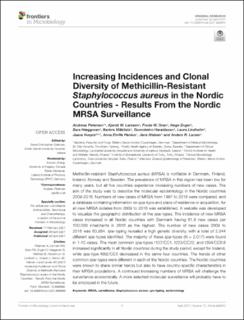| dc.description.abstract | Methicillin-resistant Staphylococcus aureus (MRSA) is notifiable in Denmark, Finland, Iceland, Norway and Sweden. The prevalence of MRSA in this region has been low for many years, but all five countries experience increasing numbers of new cases. The aim of the study was to describe the molecular epidemiology in the Nordic countries 2009-2016. Numbers of new cases of MRSA from 1997 to 2016 were compared, and a database containing information on spa-type and place of residence or acquisition, for all new MRSA isolates from 2009 to 2016 was established. A website was developed to visualize the geographic distribution of the spa-types. The incidence of new MRSA cases increased in all Nordic countries with Denmark having 61.8 new cases per 100,000 inhabitants in 2016 as the highest. The number of new cases 2009 to 2016 was 60,984. spa-typing revealed a high genetic diversity, with a total of 2,344 different spa-types identified. The majority of these spa-types (N = 2,017) were found in 1-10 cases. The most common spa-types t127/CC1, t223/CC22, and t304/CC6:8 increased significantly in all Nordic countries during the study period, except for Iceland, while spa-type t002/CC5 decreased in the same four countries. The trends of other common spa-types were different in each of the Nordic countries. The Nordic countries were shown to share similar trends but also to have country-specific characteristics in their MRSA populations. A continued increasing numbers of MRSA will challenge the surveillance economically. A more selected molecular surveillance will probably have to be employed in the future. | en_US |

